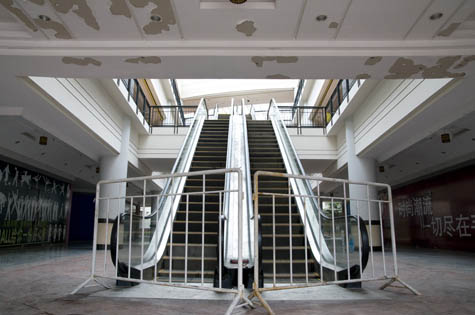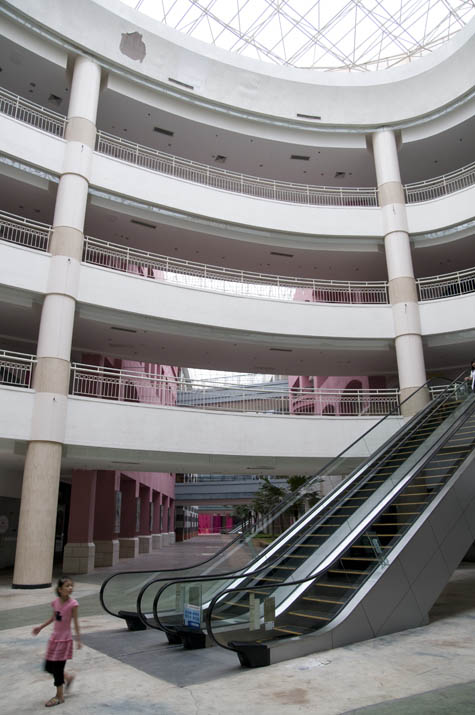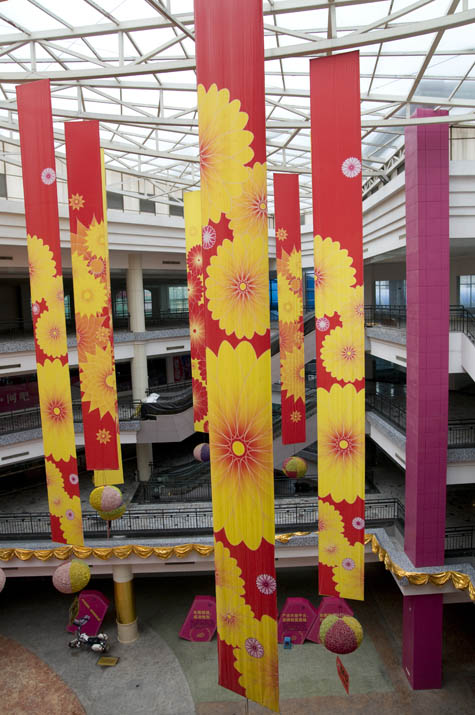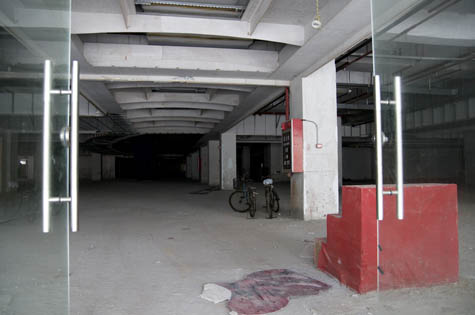Setting Up Shop in the Apocalypse
 [Image: South China Mall, photographed by Philip Gostelow for The National].
[Image: South China Mall, photographed by Philip Gostelow for The National].Last week, Jonathan Shainan of Abu Dhabi's The National newspaper sent in a link to their recent article about a rather interesting mall over in China.
That mall, we read, is "not just the world’s largest. With fewer than a dozen stores scattered through a space designed to house 1,500, it is also the world’s emptiest – a dusty, decrepit complex of buildings marked by peeling paint, dead light bulbs, and dismembered mannequins."
- What sets the South China Mall apart from [other dead malls], besides its mind-numbing size, is that it never went into decline. The tenants didn’t jump ship; they never even came on board. The mall entered the world pre-ruined, as if its developers had deliberately created an attraction for people with a taste for abandonment and decay. It is a spectacular real-estate failure – but it is also, as I saw when I spent two days exploring the site in May, a strangely beautiful monument to the big dreams that China inspires.
Like the South China Mall, these are spaces that don't simply go into decline: their expected populations just never show up.
 [Image: South China Mall, photographed by Philip Gostelow for The National].
[Image: South China Mall, photographed by Philip Gostelow for The National].In any case, the architecture of the South China Mall is itself meant to inspire:
- The big attraction of the South China Mall was supposed to be its “foreign” design. Learning from Las Vegas, where replicas of European monuments and New York landmarks draw throngs of tourists, the Dongguan mall modeled seven zones after various exotic world locations. Its rooftops reflect at least twenty different influences, from Czech town halls to Turkish mosques.
 [Image: South China Mall, photographed by Philip Gostelow for The National].
[Image: South China Mall, photographed by Philip Gostelow for The National].The article's author, Michael Donohue, soon finds himself walking past drained indoor water park rides, bored security guards, and "escalators sheathed in dust-covered plastic."
"It's not very exciting," a 23 year-old shopper comments to Donohue. She is sitting on the edge of a decorative pond somewhere deep in the emptiness.
The rest of the article is worth reading. It explores how leasing difficulties led to this situation in the first place, and how China's burgeoning "mega-middle class" has simply not arrived on time to coincide with the opening of the mall.
But what kind of future might such a giant space hold? I'd suggest that it'd make an ideal setting for an architectural studio, if such a thing hadn't been done before. Boing Boing readers suggest turning it into a venue for paint ball, or even a set for future zombie films.
 [Image: South China Mall, photographed by Philip Gostelow for The National].
[Image: South China Mall, photographed by Philip Gostelow for The National].Less tangentially, Jonathan Shainin also sent me this link to an earlier article in The National about globe-trotting mega-mall designer – turned architect of whole Middle Eastern cities – Eric Kuhne. Kuhne – who is not responsible for the South China Mall, and I don't mean to imply that he is – has become somewhat notorious for his work designing Bluewater, the giant retail "city" outside London in northern Kent. Interestingly, that mall stands in the footprint of an old quarry.
My own first sense of the cultural hostility directed at Bluewater came while reading the 2002 novel Flood by Richard Doyle, wherein the whole complex is obliterated by the rising waters of an insurgent Thames. If I remember correctly, one of the characters is trying on clothes in a changing room when water begins to seep upward through the carpeted floor.
The National article suggests that, because "Kuhne himself described Bluewater as 'a city rather than a retail destination,' it is safe to assume that his cities may resemble his malls."
- This possibility excites Kuhne; he has faith in retail. “Retail,” he tells [an] audience in Dubai, “is the only industry that can manage our city centres… We are the only ones who deal with experience. We are the only ones that understand how to customise and modify and release and replan and reorganise and administer a luscious experience for a group.”
"He views himself," the article suggests, "not as a megamall designer turning cities into supermegamalls, but as a humanistic master planner creating 'mixed use' spaces that help people live and thrive together gracefully."
In any case, what imaginative role will the South China Mall, like some massive architectural folly, play in the region? Will it take up a place in urban legends, or in video games, or in films?
Or perhaps the South China Mall will be flooded in a new, bestselling novel by a young writer from Shanghai...
Perhaps, on the other hand, China's fabled mega-middle class will arrive just in time to make it thrive. This strange ruin will then see its walls replastered and its escalators fixed, and crowds of children will walk through its cavernous toy stores unaware that the space all around them had once been an uninhabited shell.
(Thanks to Jonathan Shainin for sending both article links and the photographs by Philip Gostelow!)





Comments are moderated.
If it's not spam, it will appear here shortly!
great post and awesome pictures. how eerily cool!
Humans prefer their malls quickly blooming after the ribbon is cut, maybe because we sense the futility of attaching oneself to plaster and other cheapness. Build another close by and finish it's suffering, I say.
Meanwhile, round this parts some hotshot architect declared that people today don't need parks or greenery since malls are the new public spaces. Disposability is relative it seems.
Albany? Sorry, faulty comparison. Actually, Albany is older than NYC. A French/Dutch settlement, it had nothing to do with luring NYC's up the river. As NYS's Capital, it doesn't have to do much else except government. Troy was a 19thC industrial powerhouse (Troy Iron Works) before it's mid-20th century plunge and slow claw back.
Really, you need better examples of Potemkin Villages than the upstate Tri-city area.
There are a thousand examples of Potemkin-style cities that I could have mentioned; instead, I mentioned towns along the Hudson River. Sure, Albany isn't the best example here, and I'm aware of that - but I wasn't looking for the best example. I was looking to mention Hudson River towns, because I had just had a conversation about them. They were thus on my mind when I read the South China Mall story.
Also – sorry for the double-comment – but a Potemkin Village is something totally different than a failed city, which is why I don't use the term "Potemkin Village" in this post.
Hmm, looks like a prime site for The Blues Brothers 2020: Jake & Elwood do China.
Albany is a fine example.
I see speculative catastrophes everywhere I go. Lately I've had some business that takes me past the condo complexes along Rockville Pike just northwest of DC, where youths are trained in juggling the signage to lure motorists to each of the dozens of these large complexes. The incredible thing is that it makes good sense that the area should urbanize--it's a sensible calculation--and these buildings are not at all hack jobs. They're pretty convincing urban replicas. They're cleverly marketed. But something isn't right. They're obviously failing, and I think it has as much to do with their composition than their being ahead of the dreary market.
Who knows how long the force of entertaining youths will be sustained before they throw in the towel.
For those interested there was a short fiction piece in the May issue of Harper's called "The Next Thing" By Steven Millhauser. Very frightening not-too distant vision of what mega-malls might become in our society - reminds me of some of these images.
"This possibility excites Kuhne; he has faith in retail. 'Retail,' he tells [an] audience in Dubai, 'is the only industry that can manage our city centres…"
Oh... God... How this makes my blood pressure rise. Damn you and your management through retail, Eric Kuhne. May all of your projects be sunk in fictional floods for your overbearing assumption that a giant mall could be considered a "luscious experience".
But really - I don't think this attitude could get to me so much if the guy didn't have a point. Go out and do a survey, and you'll find lots of evidence that retail is becoming synonymous with urbanity.
At the Internationale Bauausstellung 2013 here in Hamburg, they have a nice exhibit detailing the projects that they're working on. It's in the middle of one of those little semi-covered shopping areas they used to build in the 60's, in a very diverse and also disadvantaged area called Wilhelmsburg. In the exhibit, there's a wishing wall for people to hang up their suggestions.
What is mentioned in roughly half of the suggestions for the revitalization of Wilhelmsburg?
An H&M.
Looks like even immigrant teenagers agree with Kuhne - retail makes for a luscious urban experience.
maybe it'll become a prisontainment complex - helping reform those with communist/anti-capitalist tendencies into smart consumers...
Very cool post.
I think we need to define retail. If you're living in a city, you need to be able to buy things, and it's nice when those things are close to where you live. Whether or not it needs to be an H&M or a giant mall, who knows. But it somewhat mitigates the idea and benefits of urbanism if there's only residential, no? I like the ideas behind new urbanism, but I've also seen a few that are more like malls designed to look like main street with no residential. It's all retail, all fake. It's sickening.
imagenes como esta estan muy prontas a verse... mas de lo que pensamos.
makes me think of tinseltown
Hey Morgan,
I think you're right that we need to redefine "retail". Too often it just comes to mean installing representatives of giant international conglomerates in our cities. Obviously we need this. We need H&M (I'm pretty sure I'm wearing 3 items from H&M right now in fact).
But what we also need is a meaningful local economy that allows people to take part in urban life not just by spending, but by earning their money in the place where they live.
At least, that is my opinion. It just drives me crazy that people like Kuhne would never, ever think of having small local businesses in their high-rent high-gloss complexes. Way to create an empty shell of a city center there buddy :/
This line really amuses/amazes me:
"unaware that the space all around them had once been an uninhabited shell."
It reminds me of this image, from Chris Cornish's Tate Modern.
here in China, there are uninhabited spaces all over. they are speculative real estate dreams gone awry. in such a hype based country, the combination of gangsters, optimism, and forced migration lead to so much badarchitecture and a lot of recent ruins.
Post a Comment